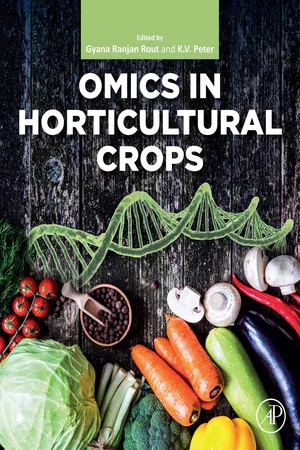
- 662 pages
- English
- ePUB (mobile friendly)
- Only available on web
Omics in Horticultural Crops
About This Book
Omics in Horticulture Crops presents a comprehensive view of germplasm diversity, genetic evolution, genomics, proteomics and transcriptomics of fruit crops (temperate, tropical and subtropical fruits, fruit nuts, berries), vegetables, tuberous crops, ornamental and floricultural crops and medicinal aromatic plants. Information covering phenomics, genetic diversity, phylogenetic studies, genome sequencing, and genome barcoding through the utilization of molecular markers plays an imperative role in the characterization and effective utilization of diverse germplasm are included in the book. This is a valuable reference for researchers and academics seeking to improve cultivar productivity through enhanced genetic diversity while also retaining optimal traits and protecting the growing environment.
- Highlights perspectives, progress and promises of -omics application
- Provides a systematic overview of origin, progenitor and domestication process as well as genetic insights
- Includes full range of horticultural crops
Frequently asked questions
Information
Table of contents
- Cover image
- Title page
- Table of Contents
- Copyright
- Contributors
- Foreword
- Preface
- Chapter 1: State of the art of omics technologies in horticultural crops
- Chapter 2: Small RNA-omics: Decoding the regulatory networks associated with horticultural traits
- Chapter 3: Multiomics bioinformatics approaches in horticultural crops
- Chapter 4: Application of omics in arid fruit crops: Present status, challenges, and future perspectives
- Chapter 5: Omics technologies and breeding of horticultural crops
- Chapter 6: Cryobiomics in tropical and subtropical horticultural crops
- Chapter 7: Application of ’omics technologies in tropical and subtropical fruit crops
- Chapter 8: Understanding grape berry development and response to environmental factors through omics approaches
- Chapter 9: Application of “omics” in banana improvement
- Chapter 10: Recent advances in pomegranate genomics: Status and prospects
- Chapter 11: Role of “Omics” approaches in sustainable development and improvement of oil palm (Elaeis guineensis Jacq)
- Chapter 12: Omics studies for vegetable improvement
- Chapter 13: Omics in vegetable crops: Cucurbitaceae and Amaryllidaceae
- Chapter 14: Omics in leafy vegetables: Genomics, transcriptomics, proteomics, metabolomics, and multiomics approaches
- Chapter 15: Omics in vegetable crops under the family Solanaceae
- Chapter 16: Omics-driven advances in plantation crops and cashew: A perspective and way forward
- Chapter 17: Omics advances in tea research
- Chapter 18: Applications of omics technologies in Coffea
- Chapter 19: Omics of mango: A tropical fruit tree
- Chapter 20: Omics in sugarcane
- Chapter 21: Omics research for crop improvement in spices
- Chapter 22: Application of omics technologies in Rubber, Cocoa, and Betel nut
- Chapter 23: Omics in tuber crops: Cassava and sweet potato
- Chapter 24: Omics in commercial flowers: Applications and prospects
- Chapter 25: Omics in medicinal plants
- Chapter 26: Omics in saffron (Crocus sativus L.): A spice of immense medicinal value
- Chapter 27: Multiomics approach in medicinal plants
- Chapter 28: Omics databases in horticultural crops
- Chapter 29: Multiomics approaches in walnut
- Index